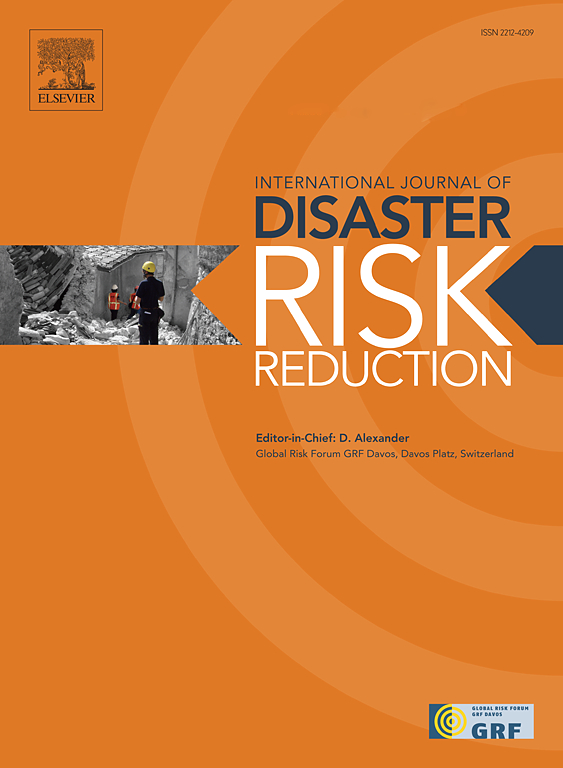运行状态对炼油厂地震风险评估的影响
IF 4.2
1区 地球科学
Q1 GEOSCIENCES, MULTIDISCIPLINARY
International journal of disaster risk reduction
Pub Date : 2024-10-15
DOI:10.1016/j.ijdrr.2024.104842
引用次数: 0
摘要
炼油厂的运营状态(任何时候的运营类型和规模)在很大程度上决定了生产、设施内循环和储油罐中的燃料量。这种状态会受到季节性、需求高峰期或低谷期以及日常维护期的影响。然而,在决定储油罐等几项关键工业资产的抗震性能以及任何潜在故障的后果的因素中,这一点却往往被忽视。本文采用了一个开放源码的炼油厂试验台,以证明炼油厂的运行状态对地震风险估算的影响。按照典型的行业惯例,在两次炼油厂重大维护停工事件之间的时间段内,开发了其他现实的运行场景。为每项资产选择最可能的损坏状态,以确定最脆弱的资产。根据受影响资产的类型和重要性,确定设施层面的潜在后果。如果地震发生在正常/高/低需求期或维护期,则得出的估算结果会截然不同。如果炼油厂的资产受到地震事件的破坏,该框架可用于确定炼油厂内可能引发连锁故障和二次破坏的位置。利益相关者、风险工程师和应急行动规划人员可利用这些成果制定定制的业务程序,以提高设施的抗震能力。本文章由计算机程序翻译,如有差异,请以英文原文为准。
Operational status effect on the seismic risk assessment of oil refineries
The operational status of an oil refinery (type and scale of operations that take place at any time instance) largely determines the amount of fuel produced, circulated within the facility, and stored in tanks. This status is affected by seasonality, periods of peak or low demand, as well as periods of routine maintenance. However, it is an aspect that is typically neglected even though it stands out among the factors that determine the seismic performance of several critical industrial assets, such as the storage tanks, as well as the consequences of any potential failure. An open-source refinery testbed is employed herein to demonstrate the effect of the refinery's operational status on the seismic risk estimates. Alternative realistic operational scenarios are developed following typical industry practices and are arranged over a time period between two refinery major maintenance shutdown events. The most probable damage state is selected for each asset to identify the most vulnerable ones. Based on the type and importance of the impacted assets, the potential consequences are determined at the facility level. Resulting estimates are very different if an earthquake strikes during a regular/high/low-demand period, or a maintenance period. The framework can be utilized to identify the locations within the refinery that may trigger cascading failures and secondary damages, should their assets be damaged by a seismic event. The outcomes can be exploited by stakeholders, risk engineers, and emergency action planners for developing customized and businesslike procedures to enhance the seismic resilience of the facility.
求助全文
通过发布文献求助,成功后即可免费获取论文全文。
去求助
来源期刊

International journal of disaster risk reduction
GEOSCIENCES, MULTIDISCIPLINARYMETEOROLOGY-METEOROLOGY & ATMOSPHERIC SCIENCES
CiteScore
8.70
自引率
18.00%
发文量
688
审稿时长
79 days
期刊介绍:
The International Journal of Disaster Risk Reduction (IJDRR) is the journal for researchers, policymakers and practitioners across diverse disciplines: earth sciences and their implications; environmental sciences; engineering; urban studies; geography; and the social sciences. IJDRR publishes fundamental and applied research, critical reviews, policy papers and case studies with a particular focus on multi-disciplinary research that aims to reduce the impact of natural, technological, social and intentional disasters. IJDRR stimulates exchange of ideas and knowledge transfer on disaster research, mitigation, adaptation, prevention and risk reduction at all geographical scales: local, national and international.
Key topics:-
-multifaceted disaster and cascading disasters
-the development of disaster risk reduction strategies and techniques
-discussion and development of effective warning and educational systems for risk management at all levels
-disasters associated with climate change
-vulnerability analysis and vulnerability trends
-emerging risks
-resilience against disasters.
The journal particularly encourages papers that approach risk from a multi-disciplinary perspective.
 求助内容:
求助内容: 应助结果提醒方式:
应助结果提醒方式:


